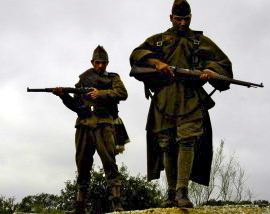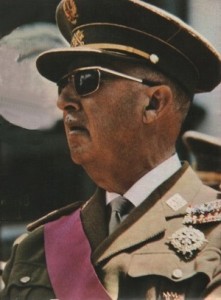“Don’t have any illusions…You and I will never see the Third Republic. We’re condemned to Franco in the same way we’re condemned to grow old and die.”
The Spanish  Civil War (1936 – 1939) and the subsequent dictatorship of General Francisco Franco form the underpinning of this hypnotic novel by Spanish author Antonio Munoz Molina, simultaneously a love story, a story about political and personal aspirations, and a story about writing and the creative process. In a narrative that swirls through time and place, often turning in upon itself and revisiting earlier events from different points of view, life during the tumultuous Civil War unfolds and is carried forward for more than thirty years of Franco’s harsh dictatorship.
Civil War (1936 – 1939) and the subsequent dictatorship of General Francisco Franco form the underpinning of this hypnotic novel by Spanish author Antonio Munoz Molina, simultaneously a love story, a story about political and personal aspirations, and a story about writing and the creative process. In a narrative that swirls through time and place, often turning in upon itself and revisiting earlier events from different points of view, life during the tumultuous Civil War unfolds and is carried forward for more than thirty years of Franco’s harsh dictatorship.
When the book opens, it is 1969, and Minaya, a university student has just been released from detention for his part in a student demonstration. He has been treated more leniently than some other protestors because of his family connections. Leaving Madrid for Magina, where his elderly uncle lives, Minaya intends to search for the missing masterwork of a little known poet named Jacinto Solana and to write his doctoral thesis on Solana in the seclusion of the countryside. His uncle Manuel and Solana were childhood friends, and both had been in love with the same woman, Mariana Rios, an artist’s model.

As the story flashes back to 1936 – 37, the complex relationship of Manuel, Solana, and Mariana unfolds. Mariana, who chose to marry Manuel, was shot to death, supposedly by a stray bullet fired from a rooftop through the window of their house on her wedding night, during the earliest days of the Spanish Civil War. Manuel never recovered, closing their nuptial bedroom and living forever after as a recluse. Solana, a Communist, went off to war and then disappeared, reappearing in Magina years later upon his release from ten years of political detention and torture. Manuel provided him with a place to live and work on his book. When Minaya arrives to stay with his uncle, Solana is already dead, according to those who knew him, shot by government troops, his papers burned, and his masterpiece, Beatus Ille, missing. With the help of Inez, who works for his uncle, Minaya searches for the manuscript, determined to restore this poet to the place he deserves as a revolutionary Spanish writer.
The intense, kaleidoscopic narrative, filled with lyrical and sensual descriptions, gradually reveals the circumstances surrounding the marriage of Manuel and Mariana and her death, at the same time that it also reveals the much later death of Solana on the “Island of Cuba,” the farm belonging to Manuel in the countryside of Magi na. Details of the civil war, its tumult, and its aftermath broaden as the communists, anarchists, members of the popular front, and supporters of the status quo, all willing to die for their beliefs, engage in battles for the future of Spain. As the narrative swirls, the multiple points of view add depth and intensity to the narrative. Though the broad outlines of the story are not in doubt, revealing details surrounding the facts accumulate as Minaya, Solana, and Manuel provide information from their own points of view, and add their personal interpretations.
na. Details of the civil war, its tumult, and its aftermath broaden as the communists, anarchists, members of the popular front, and supporters of the status quo, all willing to die for their beliefs, engage in battles for the future of Spain. As the narrative swirls, the multiple points of view add depth and intensity to the narrative. Though the broad outlines of the story are not in doubt, revealing details surrounding the facts accumulate as Minaya, Solana, and Manuel provide information from their own points of view, and add their personal interpretations.
The style is hypnotic, catching up the reader in the mood and weaving a spell, despite the fact that this unusual novel never moves in a straightforward chronological sequence and so lacks the usual beginning, middle, and end, except as the reader constructs it for him/herself. It is not unusual for some sentences to be one hundred fifty words long and for paragraphs to go on for pages, yet the narrative speeds along on the strength of the spell it weaves and the intensity of the mood it creates.

Though there are surprises at the end of this impressionistic novel, the revelations are the least important aspect of the novel. By then, the reader understands not just the circumstances of Mariana’s death and the relationships of the characters, but also the depth of Jacinto Solana’s commitment to his art and to the future of Spain. A novel that will appeal to readers willing to succumb to its mood and not worry about the long sentences, lack of direct action, and swirling chronology, A Manuscript of Ashes is an intriguing early novel by an author who is one of Spain’s most honored contemporary authors. (On my Favorites List for 2008.)
Also by Munoz Molina: IN HER ABSENCE and LIKE A FADING SHADOW
Notes: The author’s photo accompanies an interview (in Spanish) on http://www.letralia.com
Spanish Civil War photo from John Podpadec: http://www.podpadec.co.uk
The photo of Generalissimo Francisco Franco appears on http://fysm-149.wp.trincoll.edu
